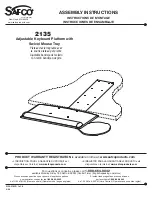
1
PP100 Series
Battery Eliminator
INSTALLATION INSTRUCTIONS
WI1576 9/06
DESCRIPTION
The PP100 is a battery eliminator that can be used with a
variety of Alarm Lock door alarms or any other device that
requires an unregulated power supply of between 6 and 9
volts. The PP100 is designed to replace all power normally
supplied by the device's internal batteries, thus allowing
these internal batteries to be used exclusively for battery
backup if AC is lost. The PP100 can be used with the fol-
lowing Alarm Lock models:
SPECIFICATIONS
Input Voltage:
105-125VAC @ 60Hz
Input Power:
10VA maximum
Output:
6-9VDC @ 0-300mA unregulated. 9 volt adapter
harness supplied.
Switchover to battery:
Automatic upon AC input failure
Shipping Weight:
3 lb., 9 oz.
Dimensions:
(LxWxD) 6" x 4
5
/
8
" x 2 ¾" (15.2cm x 11.7cm x
7cm)
Armored Cable Length:
6' (1.8m)
INSTALLATION
1. Install the device to be powered and test with its own
internal battery power, making sure the alarm sounds
properly, then reset and disconnect battery.
2. Select a suitable location for the PP100 and mount us-
ing 3 #10 x ¾" self-tapping screws and 3 flat washers
(supplied). Do not connect power at this time.
3. As per the instructions on the next page, cut a cable
notch "slot" and/or hole in the alarm box or lock cover.
Insert the PP100 armored cable end into the hole. For
surface mounted applications, secure the armored cable
with the retaining "C" ring (provided).
4. Plug the battery and load connectors from PP100 cable
into mating connectors. Refer to Figures 2 and 3 on
next page.
For 250, 700 11A, LL-1, PG10
: No adapter
is required.
For PG21 and PG30
: Use 9V adapter.
For DL locks
: Cut off all connectors at the end of the
armored cable, thus leaving only two wires (red and
black) to be connected to the DL lock's terminal strip
(see Figure 7). Batteries must remain connected as a
backup in case of AC failure.
5. For surface mounted applications, secure armored ca-
ble using cable clamps and #6 self-tapping screws
(provided). If installing on the hinge side of a door as
shown in Figure 1, be sure to leave a loop near the
hinges for flexing when door is opened and closed.
6. Insert power plug of the PP100 into a 115 VAC source.
An optional knockout is provided at power cord exit for
345 Bayview Avenue
Amityville, New York 11701
For Sales and Repairs 1-800-ALA-LOCK
For Technical Service 1-800-645-9440
Publicly traded on NASDAQ Symbol: NSSC
© ALARM LOCK 2006
connection of ½" BX or conduit if so desired.
7. Connect all plugs (and 9-volt batteries if used) as shown
in Figures 2 and 3 on next page.
TESTING
Check for proper operation under each of the following
conditions noting that the alarm sounds and/or the DL lock
functions properly.
a. PP100 connected to device, battery not connected,
PP100 plugged into 115 VAC source.
b. PP100 connected to device, battery connected, PP100
NOT plugged into 115 VAC source (pilot lamp off).
c. PP100 connected to device, battery connected, PP100
plugged into 115 VAC source.
Periodic Testing - IMPORTANT
The powered device should be tested at least once
every month to ensure that no one has tampered with
the unit and also to ensure that the backup battery is still
functional. Backup batteries should be replaced every
5-6 years.
This test must be performed with the 115 VAC input to
the PP100 disconnected.
•
250 Series
•
700 Series
•
11A Series
•
PG10 Series
•
LL-1 Series
•
PG21 Series
•
PG30 Series
•
DL Series of Digital Locks
EMERGENCY EXIT ONLY
PUSH TO OPEN & SOUND ALARM
PP100
EXIT
Install PP100
on "hinge side"
of door
Leave a loop for
flexing during
opening and
closing of door
Figure 1: Typical "Surface Mounted" Application
To 115VAC
6VDC Device






















